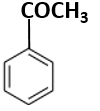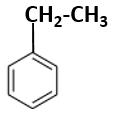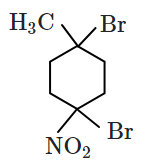Select Chapter Topics:
Compound 'A' in the reaction below, possibly, is:

1.

2.

3.

4.
Both (1) and (2)




Subtopic: Aromatic Hydrocarbons - Benzene - Structure, Preparation & Chemical Reactions |
From NCERT
Please attempt this question first.
Hints
Please attempt this question first.
The increasing order of the reactivity of the following compounds towards electrophilic aromatic substitution reaction is :
 |
 |
 |
 |
| (I) | (II) | (III) | (IV) |
1. III < I < II < IV
2. III < II < I < IV
3. I < III < IV< II
4. III < I < IV < II
Subtopic: Aromatic Hydrocarbons - Benzene - Structure, Preparation & Chemical Reactions |
From NCERT
Please attempt this question first.
Hints
Please attempt this question first.
What specific reagents are used to convert dibromoethane into benzene?
1. (a) NaOH; (b) NaNH2; (c) Red hot iron tube at 873 K
2. (a) HBr; (b) NaNH2 ; (c) KMnO4
3. (a) alc.KOH; (b) NaNH2 ; (c) H2/Pd
4. None of the above
1. (a) NaOH; (b) NaNH2; (c) Red hot iron tube at 873 K
2. (a) HBr; (b) NaNH2 ; (c) KMnO4
3. (a) alc.KOH; (b) NaNH2 ; (c) H2/Pd
4. None of the above
Subtopic: Alkanes, Alkenes and Alkynes - Chemical Properties |
From NCERT
To view explanation, please take trial in the course.
NEET 2026 - Target Batch - Vital
Hints
To view explanation, please take trial in the course.
NEET 2026 - Target Batch - Vital
The correct statement(s) among the following is/are:
1. (B) only
2. (C) only
3. (B) and (C) only
4. (A), (B), and (C)
| (A) | The boiling point of 2-methylbutane is greater than n-pentane. |
| (B) | Petrol and lower fractions of petroleum are used for dry cleaning of clothes to remove grease stains. |
| (C) | The melting point of 2,2-Dimethylpropane is greater than n-pentane. |
1. (B) only
2. (C) only
3. (B) and (C) only
4. (A), (B), and (C)
Subtopic: Aliphatic Hydrocarbon- Physical Properties |
From NCERT
Please attempt this question first.
Hints
Please attempt this question first.
Consider the following statements:
The correct statements are:
1. (a) and (b) only
2. (b) and (c) only
3. (a) and (c) only
4. (a), (b) and (c)
| a: | n-Hexane on heating in the presence of anhydrous aluminium chloride and hydrogen chloride gas isomerises to branched chain alkanes. |
| b: | 2-Methylpropane is oxidised to 2-Methylpropan-2-ol by potassium permanganate. |
| c: | Methane reacts with steam at 1273 K in the presence of nickel catalyst to form carbon dioxide and dihydrogen. |
1. (a) and (b) only
2. (b) and (c) only
3. (a) and (c) only
4. (a), (b) and (c)
Subtopic: Alkanes, Alkenes and Alkynes - Chemical Properties |
From NCERT
Please attempt this question first.
Hints
Please attempt this question first.
Consider the given two statements:
| Statement I: | Addition of \(\text{Cl}_2\) in the presence of \(\text{CCl}_4 \) with alkene will give geminal dichloride. |
| Statement II: | The addition of two moles of HCl with alkyne will give vicinal dichloride. |
| 1. | Statement I is True and Statement II is False. |
| 2. | Statement I is False and Statement II is True. |
| 3. | Both Statement I and Statement II are True. |
| 4. | Both Statement I and Statement II are False |
Subtopic: Alkanes, Alkenes and Alkynes - Chemical Properties |
From NCERT
Please attempt this question first.
Hints
Please attempt this question first.
Consider the following statements:
The correct statements is/are:
| a. | Benzene hexachloride is an aromatic compound. |
| b. | \(-NHCOCH_3\) is meta directing group towards aromatic electrophilic substitution reaction. |
| c. | In an arenium ion, one of the carbon is sp3 hybridised. |
| 1. | (a) and (b) only | 2. | (a) and (c) only |
| 3. | (c) only | 4. | (a), (b) and (c) |
Subtopic: Aromatic Hydrocarbons - Benzene - Structure, Preparation & Chemical Reactions |
From NCERT
Please attempt this question first.
Hints
Please attempt this question first.
The major product of the following reaction is:

| 1. |  |
2. |  |
| 3. |  |
4. |  |
Subtopic: Alkanes, Alkenes and Alkynes - Chemical Properties |
From NCERT
JEE
Please attempt this question first.
Hints
Please attempt this question first.
Among the following, the compound which contains the fewest tertiary carbons is:
| 1. | \((CH_3)_3C(CH_2)_2CH_3~~~~~~~~~~~~~\) |
| 2. | 4-isobutyl heptane |
| 3. |  |
| 4. |  |
Subtopic: Aliphatic Hydrocarbon- Physical Properties |
From NCERT
Please attempt this question first.
Hints
Please attempt this question first.
How many structural isomers of C₅H₁₀ are possible if cyclic structures are excluded?
1. 6
2. 4
3. 5
4. 7
Subtopic: Aliphatic Hydrocarbon -Nomenclature, Isomerism & Mechanism |
52%
From NCERT
To view explanation, please take trial in the course.
NEET 2026 - Target Batch - Vital
Hints
To view explanation, please take trial in the course.
NEET 2026 - Target Batch - Vital
Select Chapter Topics:




